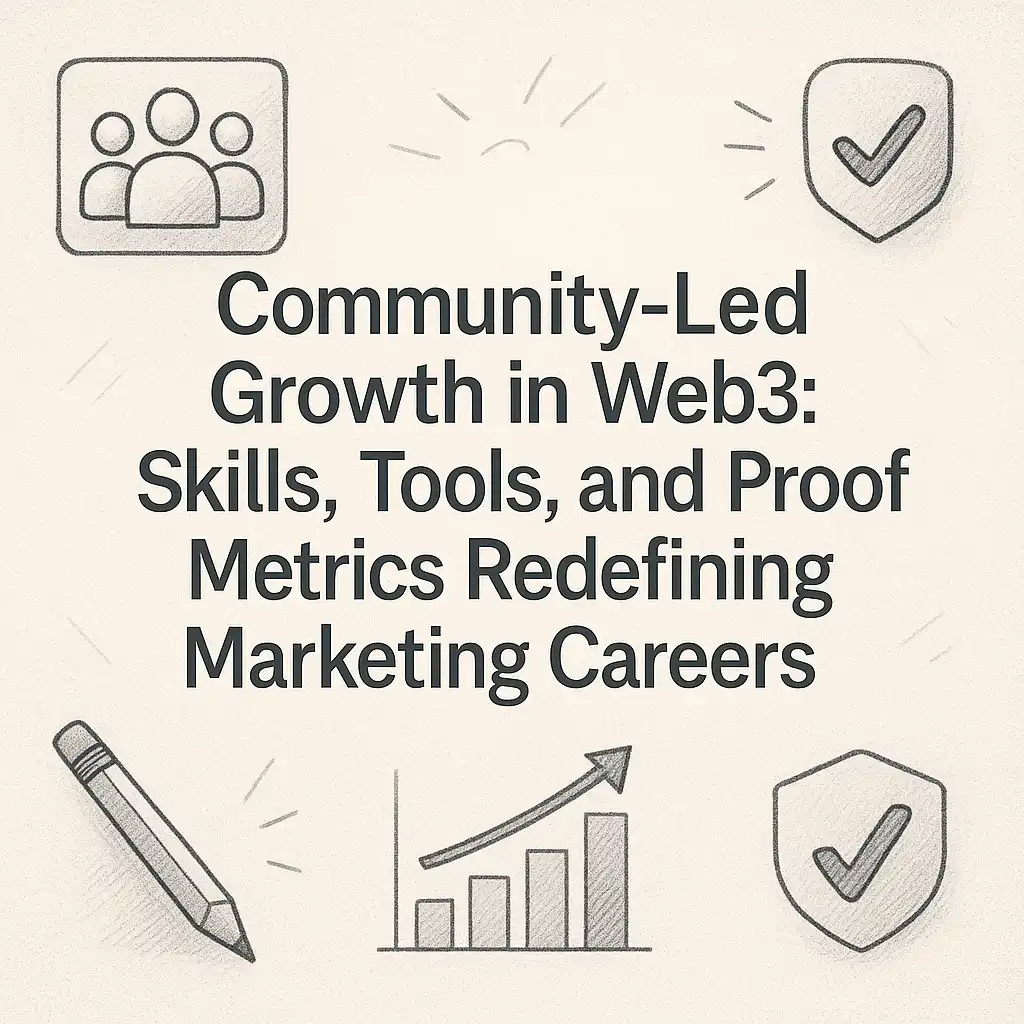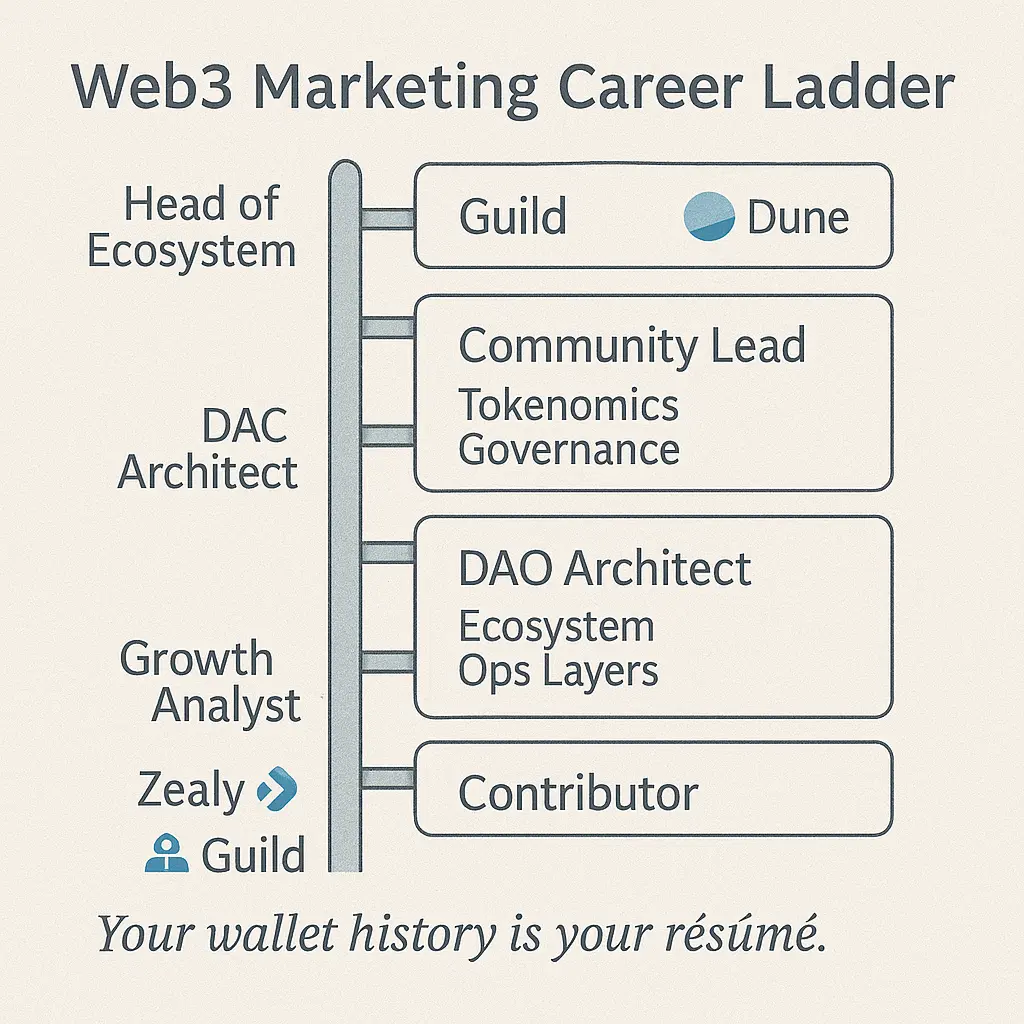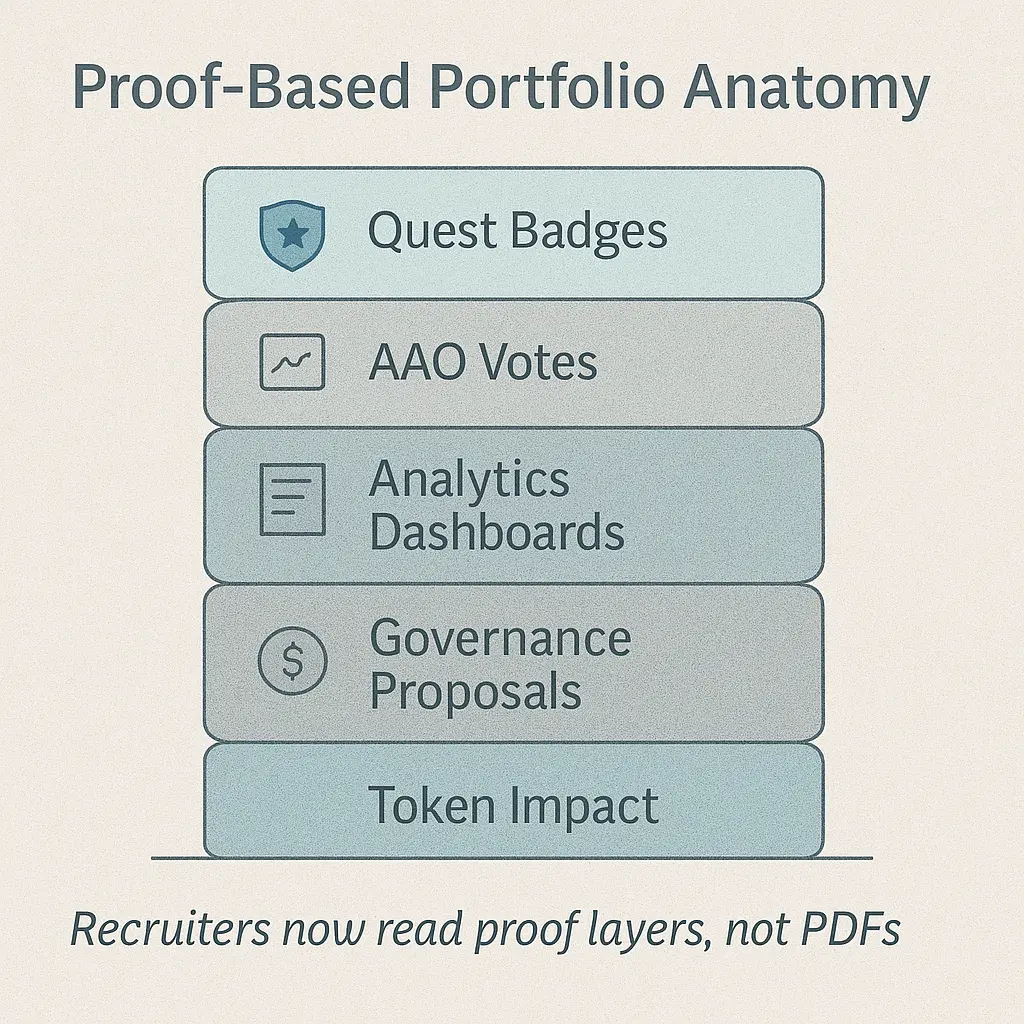Community-Led Growth in Web3: Skills, Tools, and Proof Metrics Redefining Marketing Careers

Why Web2 Marketing Playbooks Fail in Web3
The marketing rulebook that worked for Web 2.0—funnels, paid ads, and top-down messaging—starts to crumble once ownership and on-chain proof enter the picture. In Web3, audiences aren’t just consumers; they’re stakeholders with tokens, voting rights, and community equity. A project’s brand reach can look impressive on X or Discord while its wallet activity quietly declines—a scenario that kills most airdrop-fueled projects within months.
In traditional marketing, growth meant conversions. In Web3, growth means retention powered by belief and proof. Every campaign is judged not only by engagement rates but by how much skin-in-the-game users actually keep after the hype.
This shift has redefined what “marketing career” means. Instead of optimizing CPMs, Web3 marketers read dashboards like on-chain analysts. They evaluate DAOs by governance participation KPI, track token liquidity over followers, and measure active wallets per quest rather than likes per post.
So, how do professionals prepare for this new era—where storytelling, analytics, and community design blend into one career path?
Let’s break it down.
👉 TL;DR
Community > Audience: Ownership replaces attention; members become marketers.
Proof > Promises: On-chain metrics validate brand trust (source: [Bankless]).
Tool Stack: Guild.xyz, Charmverse, Dune, Nansen, and Layer3 dashboards drive growth experiments.
New KPIs: Retention after airdrop, DAO governance rates, and wallet recurrence.
Career Shift: Web3 marketers need tokenomics literacy + data storytelling + community ops.
Proof Careers: Portfolios show impact through on-chain campaign data
(Explore more → /discussion/what-defi-startups-expect-from-community-managers-who-track-on-chain-engagement).
Future Outlook: Community-led growth is becoming the default for DeFi, NFTs, and DAOs.
Why Community-Led Growth Matters in Web3

In Web2, communities were marketing extensions—Facebook groups or Reddit threads that supported a brand. In Web3, they are the brand. A DAO’s reputation, token value, and recruitment pipeline depend on how its members act. The line between audience and employee is blurred; contributors earn tokens instead of titles.
Take early DeFi projects: their growth wasn’t driven by ads but by believers who created memes, translated docs, and wrote threads for free. But once the airdrop ended, many communities collapsed because they had no retention metrics to sustain momentum. That’s why modern growth teams track wallet cohorts instead of follower spikes
Community-led growth (CLG) is a system where trust and participation replace ads and algorithms. Your community is the acquisition engine and retention loop combined. This means marketers need to learn what product managers and data scientists once did: defining KPIs that reflect long-term value. Instead of “reach,” the north-star metric is often wallets returning for multiple governance votes or staking events.
To succeed in this landscape, you need a hybrid skill mix—narrative crafting to unite a community and data fluency to prove its impact. Projects like NounsDAO and Optimism show how transparent governance can turn users into long-term advocates (source: [Messari]).
When every action is on-chain, community marketing becomes not about claims but about evidence.
The Skill Shift for Web3 Marketers
A Web3 marketer is no longer a social-media manager with crypto buzzwords. They’re part data analyst, part community strategist, part token economist. Because campaigns live on-chain, their results can be verified publicly by anyone. That accountability demands both technical and ethical literacy.
Key Skill Shifts:
From Vanity to Verifiable Metrics: Understand tools like Dune and Nansen to analyze on-chain behavior.
From Follower Growth to Retention: Use Guild or Layer3 to track engagement through quests and NFT badges (source: [CoinDesk Academy]).
From Campaigns to Communities: Master DAO tools like Charmverse and Coordinate to reward contributors with proof of work.
From Narrative to Governance: Understand tokenomics, treasury votes, and KPIs before building a marketing plan
The next generation of marketers won’t just launch campaigns—they’ll design systems where growth is co-owned and measurable. Their portfolios will show impact proofs, not PDF reports: retention curves, voting charts, and token distribution dashboards. /article/how-recruiters-read-your-github-2025-building-proof-stacks-for-blockchain-trust).
(external source → [https://github.com/BanklessDAO/bankless-dao-constitution/branches])
Key Takeaways
Community is the new marketing department.
Proof of impact is the currency for career growth.
On-chain tools replace traditional dashboards.
DAO governance and airdrop retention are the new KPIs.
Marketers who learn data analysis will lead the next Web3 growth wave.
(Join related AOB threads →
/discussion/how-do-you-measure-growth-and-engagement-as-a-web3-community-manager,
/discussion/what-defi-startups-expect-from-community-managers-who-track-on-chain-engagement)
The Modern Web3 Growth Stack — Tools Built for Proof, Not Hype

Every Web3 community lives and dies by data you can actually verify. That’s why the best marketers build their strategy around transparent, on-chain tools rather than paid dashboards or vanity numbers.
1. Community & Quest Platforms
Guild.xyz, Layer3, Zealy, and Galxe have replaced “follow-and-win” giveaways with proof-of-participation. These platforms let marketers design campaigns where actions—wallet connections, governance votes, NFT mints—are instantly verifiable. They also allow filtering members by real contribution level rather than social metrics.
(Explore more → /discussion/how-do-you-measure-growth-and-engagement-as-a-web3-community-manager)
2. DAO Management & Contributor Tools
Charmverse, Coordinape, and Dework are the new CRMs for decentralized work. They connect contributor activity with token rewards, letting growth leads measure campaign ROI in tokens distributed vs. engagement achieved. This aligns incentives across marketing and operations.
(Explore more → /discussion/how-dao-growth-teams-define-retention-after-an-airdrop)
3. Analytics and Dashboards
Dune, Nansen, and Flipside Crypto help translate on-chain chaos into actionable insights. Marketers use them to track metrics like wallet recurrence, staking depth, and treasury participation. Instead of “impressions,” dashboards show active governance votes—a truer measure of community belief.
(source: [Messari Community Report])
4. Automation & CRM Bridges
Tools such as Zapier + Notion, Airtable + Guild, and Make.com integrations connect off-chain marketing systems with on-chain triggers. Example: when a wallet completes a quest, it auto-adds that user to a nurture workflow. These stacks merge Web2 CRM precision with Web3 transparency.
When airdrops or quests are tracked in real time, teams can A/B test governance conversion—how many questers eventually vote or stake. That feedback loop makes community-led growth scientific rather than speculative.
Metrics That Actually Matter in Web3 Growth

Traditional metrics like CPM or click-through rate fail because they measure visibility, not ownership. Web3 demands new north-star metrics that reveal how deeply users are invested in the ecosystem.
A. Retention After Airdrop
The ultimate truth test. Many projects lose 70–90 % of users within weeks of an airdrop. The retention metric tracks wallets that keep interacting even after incentives end. Sustained interaction proves real belief.
(Explore more → /discussion/how-web3-startups-define-retention-after-token-launch-in-india-for-growth)
B. Governance Participation Rate
DAO success depends on active voters, not token holders. This metric calculates the percentage of holders participating in proposals. A project with 1 % voter turnout looks decentralized only on paper; 20 % means a living community.
C. Wallet Recurrence & Cohort Behavior
Using Dune queries, marketers can group wallets by behavior—first-time, repeat, dormant—and predict churn before it happens. Cohort dashboards are replacing CRMs as retention tools.
D. Contributor Proofs
A “proof” is a verified on-chain action—content published, bug reported, or quest completed. Over time, these proofs create a reputation layer that follows the marketer across DAOs. Recruiters now ask to see this evidence rather than campaign decks.
(Explore more → /article/proof-heavy-smart-contract-portfolios-what-hiring-managers-actually-trust-2025-edition)
E. Community Sentiment and Token Health Metrics
Tools like Nansen label smart-money wallets to detect when loyal supporters start exiting. Combined with Discord health metrics—active threads, proposal feedback—these form a 360° picture of trust.
Together, these KPIs shift the marketer’s focus from attention → action → advocacy → ownership.
Transitioning from Web2 to Web3 Marketing — A Career Playbook
Many traditional marketers feel locked out of Web3 because it looks too technical. In reality, 70 % of Web3 growth work still relies on human storytelling—only the data layer has changed.
Step 1: Translate Existing Strengths
If you’ve run social campaigns, you already understand audience psychology. The upgrade is learning how tokens, quests, and DAOs change incentive design. Start with public dashboards—observe how Layer3 or Optimism communities track participation.
Step 2: Learn On-Chain Literacy
Basic Etherscan navigation, understanding token supply, and reading simple Dune queries are the new literacy markers. Web3 marketers don’t code smart contracts, but they must know what the data means.
(Explore more → /discussion/about-web3-non-tech-roles-finance-consulting-marketing-operations-etc)
Step 3: Build a Proof-Driven Portfolio
Instead of screenshots, link to your quest campaigns, DAO votes, or on-chain analytics boards. Hiring teams verify claims instantly. Treat your wallet history as your résumé—transparent, timestamped, and reputation-building.
(Explore more→ /discussion/how-to-showcase-dao-resume-experience-for-your-next-web3-role)
Step 4: Engage Communities Before You Pitch Jobs
DAO forums, Discord servers, and governance calls are open classrooms. Participating early builds visibility faster than cold applications. Even a few thoughtful posts in DAO governance threads can outperform dozens of résumés.
(Explore more → /discussion/learning-a-web3-skill-and-building-personal-brand)
Step 5: Adopt Proof-First Thinking
Every marketing decision—from a meme drop to a referral campaign—should ask, “Can this be proven on-chain?” That mindset separates sustainable brands from hype cycles.
7️⃣ The Future: Marketing as Governance
In the coming years, “marketing” and “governance” will blur. Campaigns will fund themselves through DAO treasuries, and contributors will vote on narrative direction. Growth managers will become community economists who balance token supply with engagement demand.
When every action is transparent, authenticity becomes the growth hack. The projects that thrive will be those whose communities market themselves—not because they’re told to, but because they’re rewarded to.
Beginner Path — From Curiosity to Contribution

Starting a career in community-led Web3 marketing doesn’t need a technical degree. What matters most is curiosity about how decentralized systems build trust.
Step 1: Join and Observe.
Pick one DAO or NFT community and follow their governance votes, Discord calls, and quest launches. Observation teaches how decisions and incentives connect.
(Explore more → /discussion/how-do-you-measure-growth-and-engagement-as-a-web3-community-manager)
Step 2: Complete Micro-Proofs.
Start with small, measurable actions—translating a post, testing a quest, or writing feedback on Layer3. Each action becomes an on-chain proof of participation.
Step 3: Learn Analytics in Context.
Open public Dune dashboards and understand what each query represents. Instead of memorizing jargon like “TVL,” focus on what it signals—capital confidence, community belief, or liquidity stickiness.
Step 4: Document Everything.
Create a simple Notion or GitHub page summarizing your contributions with wallet-based screenshots. Employers prefer visible, timestamped effort to polished résumés.
(Explore more→ /discussion/how-to-showcase-dao-resume-experience-for-your-next-web3-role)
After 3–6 months, most consistent contributors naturally progress into Community Analyst or Quest Ops Assistant roles—proof that participation > application.
Recruiter Insights — What They Actually Look For in 2025

Recruiters no longer rely on polished PDFs; they look for wallets and real activity. Hiring panels at DAO-driven startups have adapted new ways to verify marketing credibility.
1. Proof over Profile.
They open Guild or Zealy dashboards to confirm a candidate’s quest history. A consistent streak of contributions matters more than a list of brand names.
(Explore more → /article/proof-heavy-smart-contract-portfolios-what-hiring-managers-actually-trust-2025-edition)
2. Cross-Functional Awareness.
The ideal Web3 marketer understands enough tech to talk to developers and enough strategy to talk to investors. Recruiters test for “bridge” ability—can you turn tokenomics into plain English?
3. Ownership Signals.
Recruiters study on-chain governance records. Someone who has voted on treasury proposals or participated in community funding shows genuine skin in the game.
(Explore more → /discussion/about-web3-non-tech-roles-finance-consulting-marketing-operations-etc)
4. Transparency and Ethics.
Since all data is public, exaggeration is easy to spot. Integrity and context framing—admitting what went wrong in a campaign—often impress more than perfect metrics.
Recruiters now describe portfolios as “proof stacks”—linked dashboards, DAO votes, and case studies proving measurable contribution
The Career Ladder — From Contributor to Community Architect
Web3 marketing careers don’t follow corporate ladders—they evolve through visibility, proof, and governance influence.
Stage 1 — Community Contributor (0–6 months)
Role focus: Executing quests, moderating, or writing educational content.
Goal: Accumulate on-chain proofs and social credibility.
Stage 2 — Growth Analyst / Ops Associate (6–12 months)
Role focus: Tracking wallet metrics, setting KPIs for DAO campaigns.
Tools: Dune, Guild, Layer3, and Notion.
Stage 3 — Community Lead / Growth Strategist (1–2 years)
Role focus: Designing incentive loops, collaborating with token engineers.
Deliverable: Retention dashboards, governance analytics, and event-based KPIs.
(Explore more → /discussion/how-dao-growth-teams-define-retention-after-an-airdrop)
Stage 4 — Community Architect / DAO Economist (2 + years)
Role focus: Aligning tokenomics with behavioral psychology. Oversees marketing, treasury, and contributor incentives.
Skills: Advanced analytics, leadership in decentralized governance, and strategic communications.
Stage 5 — Head of Ecosystem Growth / Chief Community Officer
This top-tier role blends storytelling, data, and diplomacy. They manage multi-DAO partnerships, ensure cross-chain narrative alignment, and lead proof-based marketing ecosystems.
(Explore more → /discussion/how-web3-startups-define-retention-after-token-launch-in-india-for-growth)
Unlike Web2, promotions come through reputation compounding, not HR approvals. When your on-chain actions inspire forks or imitators, the ecosystem promotes you naturally.
Real-World Challenges in Community-Led Marketing
Even the most passionate Web3 marketers face steep learning curves. Understanding these challenges early helps sustain momentum.
1. Signal vs Noise.
Every project promises “community,” but many chase short-term engagement. Filtering hype from genuine governance cultures takes time and research.
(Explore more → /discussion/what-are-the-ethical-considerations-of-working-as-a-smart-contract-developer)
2. Burnout from Always-On Workflows.
DAO participation rarely follows office hours. Notifications across Discords and governance portals can overwhelm newcomers. The fix is discipline—schedule proof submissions like work tasks.
3. Unclear Pay and Token Value.
Because compensation often includes native tokens, marketers must assess tokenomics to estimate real income. Learning vesting schedules and liquidity depth becomes a survival skill.
(Explore more → /discussion/web3-job-offer-assessment-token-compensation)
4. Fragmented Learning Resources.
Unlike Web2’s formal courses, Web3 learning is community-driven. Platforms like Bankless Academy, OdysseyDAO, and ArtofBlockchain threads fill the gap but require self-direction.
5. Proof Fatigue.
When every action must be verified, marketers may feel constant performance pressure. Healthy boundaries and clear documentation habits prevent burnout.
Despite these challenges, community-led growth offers unmatched career resilience. The more value you prove on-chain, the more portable your reputation becomes across ecosystems.
(Explore more → /discussion/learning-a-web3-skill-and-building-personal-brand)
https://github.com/BanklessDAO/bankless-dao-constitution/branches
The Future Outlook — Proof-Based Growth Becomes the Default

Community-led growth is no longer an experimental playbook — it’s becoming Web3’s default operating model.
Over the next few years, most decentralized projects will treat community data as their core marketing asset.
Three shifts are already visible:
1. Marketing Becomes Governance.
Future campaigns will originate inside DAO votes. Instead of CMOs, we’ll see Community Treasury Councils allocating budgets for storytelling, analytics, and partnerships.
(Explore more → /discussion/how-dao-growth-teams-define-retention-after-an-airdrop)
2. Proof Replaces Portfolios.
Employers won’t ask for PDFs — they’ll review your wallet, quests, and dashboards. Proof-heavy resumes will serve as decentralized professional identities.
3. Automation Bridges Web2 and Web3.
Marketers will use CRMs that pull real-time data from smart contracts and token treasuries. AI tools will summarize wallet cohorts and recommend incentive adjustments dynamically.
The outcome? Marketing will evolve from persuasion to participation. Those who can translate data into stories will lead the new generation of Web3 growth.
Key Takeaways
Ownership > Attention: Web3 growth depends on co-creation, not campaigns.
Proof > Promise: Success is measured through on-chain actions, not impressions.
Hybrid Skillset: Data + Community + Storytelling = career resilience.
DAO Governance = New Marketing: Decision-making and growth budgets are community-owned.
Proof Portfolios Build Trust: Recruiters and DAOs verify your work via transparent metrics.
(Join related AOB threads → /discussion/how-web3-startups-define-retention-after-token-launch-in-india-for-growth, /discussion/what-defi-startups-expect-from-community-managers-who-track-on-chain-engagement)
FAQs
Q1. What is community-led growth in Web3?
Community-led growth in Web3 means the project’s users and token holders—not a central marketing team—drive awareness and engagement. Members co-create content, manage governance votes, and build trust through on-chain participation. It replaces one-way advertising with transparent collaboration and ownership signals recorded on the blockchain.
Q2. How is Web3 marketing different from Web2 marketing?
Web2 marketing focuses on clicks, conversions, and paid visibility, while Web3 marketing tracks proof-based actions such as wallet activity, DAO voting, or staking participation. Instead of relying on impressions, marketers measure engagement through ownership. This shift rewards authentic community interaction over short-term campaign performance.
Q3. What skills do I need for a Web3 marketing career?
A strong Web3 marketer blends storytelling, community operations, and on-chain data literacy. You should understand how tokenomics, governance, and analytics dashboards (like Dune or Nansen) reflect user trust. Soft skills like transparency, empathy, and decentralized teamwork matter as much as technical familiarity with DAO tools.
Q4. Can non-technical professionals enter Web3 growth or DAO marketing roles?
Absolutely. Many successful contributors in DAO marketing, community strategy, or partnership growth come from traditional backgrounds in communication, finance, or operations. What matters most is learning blockchain basics and consistently showing proof of participation through quests, proposals, and measurable campaign results.
Q5. What metrics should I track as a Web3 community manager?
Focus on actionable metrics that reflect user loyalty, not vanity numbers. The key ones are retention after airdrop, governance participation rate, and wallet recurrence. These on-chain KPIs reveal how deeply your community believes in the project and whether engagement leads to sustained growth.
Q6. How do I build a proof-based marketing portfolio?
A proof-based portfolio showcases verifiable work—like DAO votes, quest completions, or analytics dashboards—instead of screenshots. You can publish your contributions on Notion, GitHub, or Guild, linking each to your wallet or campaign results. Recruiters value transparent, timestamped evidence because it reflects credibility and community impact.
Q7. What are the biggest challenges in Web3 community-led marketing?
Marketers face issues like volatile token compensation, inconsistent governance participation, and proof fatigue from constant validation. Balancing transparency with mental well-being is key. Understanding tokenomics helps evaluate real compensation value, while documentation habits prevent burnout in always-on DAO environments.
Q8. Where can I learn Web3 growth and community-building skills?
Join learning-driven communities like Bankless Academy, OdysseyDAO, and ArtofBlockchain.club to gain practical insights. Participating in live DAO discussions, marketing threads, or airdrop strategy sessions helps you understand how community-led growth careers evolve in real time. Real practice builds far more proof than theory.